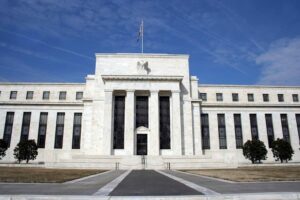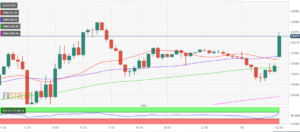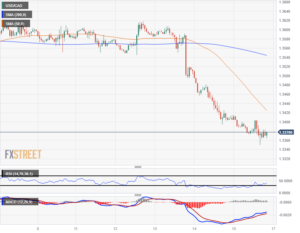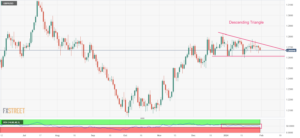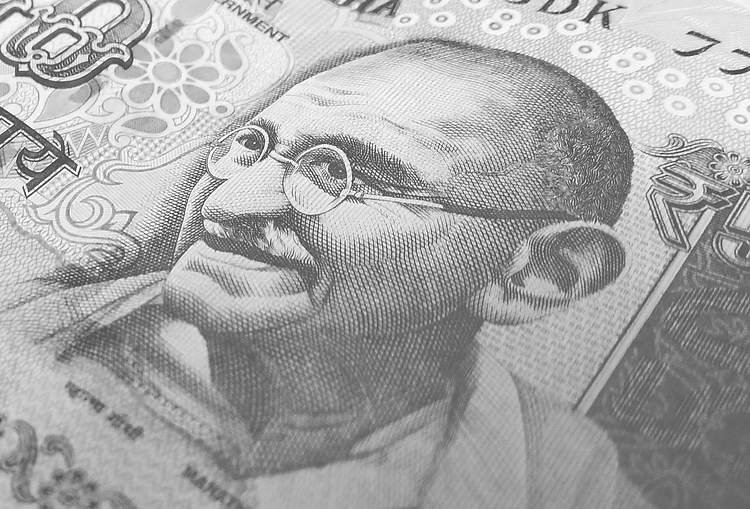
- Indian Rupee trades firmly, supported by the potential aggressive intervention by the Reserve Bank of India (RBI).
- A rise in US Treasury yields and higher crude oil prices might cap the upside of the Indian Rupee.
- Investors will focus on the RBI Forex swap maturity, US economic data.
Indian Rupee (INR) posts modest gains on Monday. The strengthening of the Indian Rupee is bolstered by the potential aggressive intervention by the Reserve Bank of India (RBI) last week. However, the anticipation that the Federal Reserve (Fed) will hold rates ‘higher for longer’ lifts the US Treasury yields near multi-year highs. However, a rise in oil prices might cap the upside of the Indian Rupee.
Traders will keep an eye on a $5 billion RBI swap transaction, which is set to mature on Monday. The maturity of the USD/INR swaps will wipe out $5 billion from the system while injecting about 400 billion Rupees. Furthermore, the release of the US S&P Global PMI, the first reading of Q3 Gross Domestic Product (GDP), and the Core Personal Consumption Expenditures (PCE) data this week will be closely watched by traders.
Daily Digest Market Movers: Indian Rupee gains traction amid the uncertainty
- Net foreign direct investment (FDI) in India fell from $18.03 billion in April-August last year to $2.99 billion this year, reflecting a slowing in global activity and a rise in repatriation.
- Fed Chair Jerome Powell and other officials expressed a desire to hold rates unless inflation rises.
- September’s US budget deficit was $170 billion. The overall 2023 budget deficit was $1.695 trillion, 23% larger than the previous year and exceeding all pre-COVID deficits.
- RBI Chief Shaktikanta Das said the central bank does intervene in the forex market, but only to prevent excessive volatility of the Indian Rupee.
- Chief Das stated that RBI will monitor the evolving inflation dynamic amid the uncertainty on food inflation.
- India’s Finance Minister will focus on the impact of ongoing tensions in the Middle East on the supply chain.
- The Indian government is concerned with the settlement currency, the yuan, as Indian refiners have used the yuan to pay for some oil from Russian sellers.
- The RBI’s October bulletin suggested growth is expected to gain momentum through the rest of the year.
- The RBI sold a net $3.86 billion in the spot foreign exchange market in August.
- India’s Wholesale Price Index (WPI) for September came in at -0.26% YoY from 0.52% in the previous reading, missing the market estimation of 0.50%.
Technical Analysis: Indian Rupee holds above the key support level around the 83.00 area
The Indian Rupee kicks off the week in a positive mood against the US Dollar (USD). The USD/INR pair trades within a narrow range of 83.15-83.30 and the key contention level is seen at the 83.00 psychological round mark. A breach below the latter could see a drop to 82.82 (low of September 12), followed by 82.65 (low of August 4). On the upside, the first resistance level for USD/INR is located near a high of October 4 at 83.30, en route to the all-time high around 83.45, followed by a psychological figure at 84.00. In the meantime, the pair holds above the 100- and 200-day Exponential Moving Averages (EMA) on the daily chart, which hints that further upside looks favorable.
US Dollar price today
The table below shows the percentage change of US Dollar (USD) against listed major currencies today. US Dollar was the strongest against the Swiss Franc.
| USD | EUR | GBP | CAD | AUD | JPY | NZD | CHF | |
| USD | 0.11% | 0.10% | 0.05% | 0.12% | 0.04% | 0.05% | 0.21% | |
| EUR | -0.12% | -0.02% | -0.07% | 0.00% | -0.08% | -0.07% | 0.10% | |
| GBP | -0.10% | 0.00% | -0.06% | 0.01% | -0.06% | -0.06% | 0.12% | |
| CAD | -0.04% | 0.06% | 0.02% | 0.07% | 0.00% | 0.00% | 0.19% | |
| AUD | -0.12% | 0.02% | 0.00% | -0.07% | -0.06% | -0.07% | 0.12% | |
| JPY | -0.03% | 0.06% | 0.05% | 0.00% | 0.05% | 0.02% | 0.20% | |
| NZD | -0.04% | 0.07% | 0.05% | -0.01% | 0.07% | 0.00% | 0.19% | |
| CHF | -0.24% | -0.13% | -0.15% | -0.19% | -0.13% | -0.20% | -0.19% |
The heat map shows percentage changes of major currencies against each other. The base currency is picked from the left column, while the quote currency is picked from the top row. For example, if you pick the Euro from the left column and move along the horizontal line to the Japanese Yen, the percentage change displayed in the box will represent EUR (base)/JPY (quote).
RBI FAQs
The role of the Reserve Bank of India (RBI), in its own words, is “..to maintain price stability while keeping in mind the objective of growth.” This involves maintaining the inflation rate at a stable 4% level primarily using the tool of interest rates. The RBI also maintains the exchange rate at a level that will not cause excess volatility and problems for exporters and importers, since India’s economy is heavily reliant on foreign trade, especially Oil.
The RBI formally meets at six bi-monthly meetings a year to discuss its monetary policy and, if necessary, adjust interest rates. When inflation is too high (above its 4% target), the RBI will normally raise interest rates to deter borrowing and spending, which can support the Rupee (INR). If inflation falls too far below target, the RBI might cut rates to encourage more lending, which can be negative for INR.
Due to the importance of trade to the economy, the Reserve Bank of India (RBI) actively intervenes in FX markets to maintain the exchange rate within a limited range. It does this to ensure Indian importers and exporters are not exposed to unnecessary currency risk during periods of FX volatility. The RBI buys and sells Rupees in the spot market at eys levels, and uses derivatives to hedge its positions.
- SEO Powered Content & PR Distribution. Get Amplified Today.
- PlatoData.Network Vertical Generative Ai. Empower Yourself. Access Here.
- PlatoAiStream. Web3 Intelligence. Knowledge Amplified. Access Here.
- PlatoESG. Carbon, CleanTech, Energy, Environment, Solar, Waste Management. Access Here.
- PlatoHealth. Biotech and Clinical Trials Intelligence. Access Here.
- Source: https://www.fxstreet.com/news/indian-rupee-gains-momentum-eyes-on-us-bond-yield-oil-prices-202310230304
- :is
- :not
- ][p
- $2.99
- $3
- 1
- 12
- 2023
- 30
- 32
- 36
- 400
- 41
- 65
- 84
- a
- About
- above
- actively
- activity
- adjust
- against
- aggressive
- All
- along
- also
- Amid
- an
- analysis
- and
- Animate
- anticipation
- ARE
- around
- AS
- At
- AUGUST
- Bank
- Bank of India
- base
- BE
- below
- Billion
- bond
- Borrowing
- Box
- breach
- budget
- bulletin
- but
- Buys
- by
- came
- CAN
- cap
- Cause
- central
- Central Bank
- chain
- Chair
- change
- Changes
- Chart
- chief
- closely
- Column
- concerned
- Concerns
- consumption
- content
- Core
- could
- crude
- Crude oil
- currencies
- Currency
- Cut
- daily
- data
- DEFICIT
- Derivatives
- desire
- Digest
- direct
- discuss
- displayed
- does
- Dollar
- Domestic
- Drop
- during
- dynamic
- each
- East
- Economic
- economy
- EMA
- encourage
- ends
- ensure
- especially
- Ether (ETH)
- EUR
- Euro
- evolving
- example
- excess
- exchange
- Exchange rate
- expanded
- expected
- exponential
- exposed
- expressed
- eye
- Eyes
- Falls
- FAQ
- far
- favorable
- Fed
- Federal
- federal reserve
- Figure
- finance
- FINANCE MINISTER
- firmly
- First
- Focus
- followed
- food
- For
- foreign
- foreign exchange
- foreign exchange market
- foreign trade
- forex
- forex market
- Formally
- Franc
- from
- further
- Furthermore
- FX
- FX markets
- Gain
- Gains
- GDP
- Global
- Government
- Growth
- Have
- heavily
- hedge
- High
- higher
- Highs
- hints
- hold
- holds
- Horizontal
- However
- HTTPS
- if
- Impact
- importance
- in
- index
- india
- Indian
- indian government
- inflation
- inflation rate
- interest
- Interest Rates
- intervene
- intervention
- investment
- involves
- IT
- ITS
- Japanese
- Japanese Yen
- jerome
- jerome powell
- jpg
- Keep
- keeping
- Key
- Kicks
- larger
- Last
- Last Year
- left
- lending
- Level
- levels
- Limited
- Line
- Listed
- located
- LOOKS
- Low
- maintain
- maintaining
- maintains
- major
- map
- mark
- Market
- Markets
- mature
- maturity
- meantime
- meetings
- Meets
- Middle
- Middle East
- might
- mind
- minister
- missing
- modest
- module
- Momentum
- Monday
- Monetary
- Monetary Policy
- Monitor
- mood
- more
- move
- Movers
- moving
- moving averages
- multi-year
- Near
- necessary
- negative
- net
- normally
- objective
- october
- of
- off
- officials
- Oil
- on
- ongoing
- only
- Other
- out
- overall
- own
- pair
- Pay
- pce
- percentage
- periods
- personal
- pick
- picked
- plato
- Plato Data Intelligence
- PlatoData
- pmi
- policy
- positions
- positive
- Posts
- potential
- Powell
- pre-COVID
- prevent
- previous
- price
- Prices
- primarily
- problems
- psychological
- Q3
- quote
- raise
- range
- Rate
- Rates
- RBI
- Reading
- reflecting
- release
- represent
- Reserve
- reserve bank
- Reserve Bank of India
- Resistance
- REST
- Rise
- Rises
- Risk
- Role
- round
- Route
- ROW
- russian
- s
- S&P
- S&P Global
- Said
- see
- seen
- Sellers
- Sells
- September
- set
- settlement
- Shows
- since
- SIX
- Slowing
- sold
- some
- Spending
- Spot
- spot market
- Stability
- stable
- starts
- stated
- strengthening
- strongest
- supply
- supply chain
- support
- support level
- Supported
- swap
- Swaps
- Swiss
- system
- table
- Target
- tensions
- than
- that
- The
- The Reserve Bank of India
- this
- this week
- this year
- Through
- to
- today
- too
- tool
- top
- traction
- trade
- Traders
- trades
- transaction
- treasury
- Treasury yields
- Trillion
- Uncertainty
- Upside
- us
- US Dollar
- US Treasury
- US treasury yields
- USD
- usd/inr
- used
- uses
- using
- Volatility
- was
- week
- when
- which
- while
- wholesale
- will
- wipe
- with
- within
- words
- year
- Yen
- Yield
- yields
- you
- Yuan
- zephyrnet

